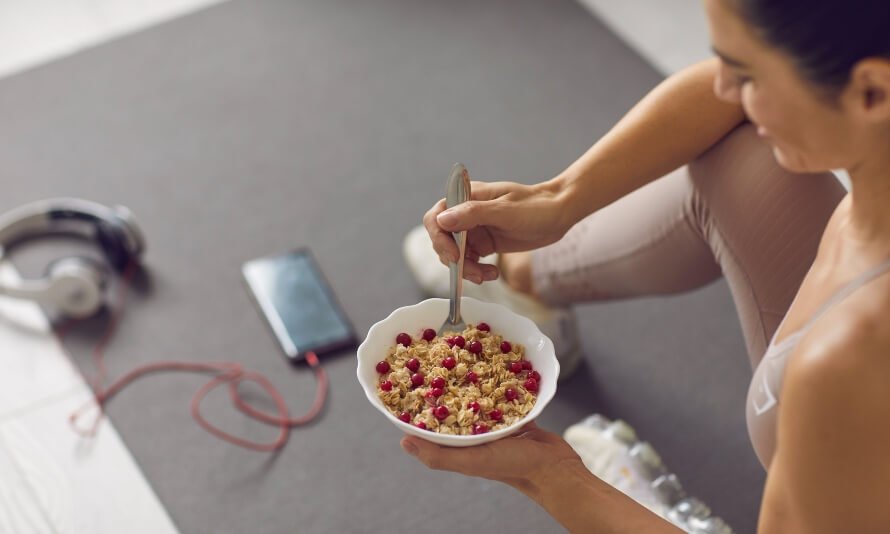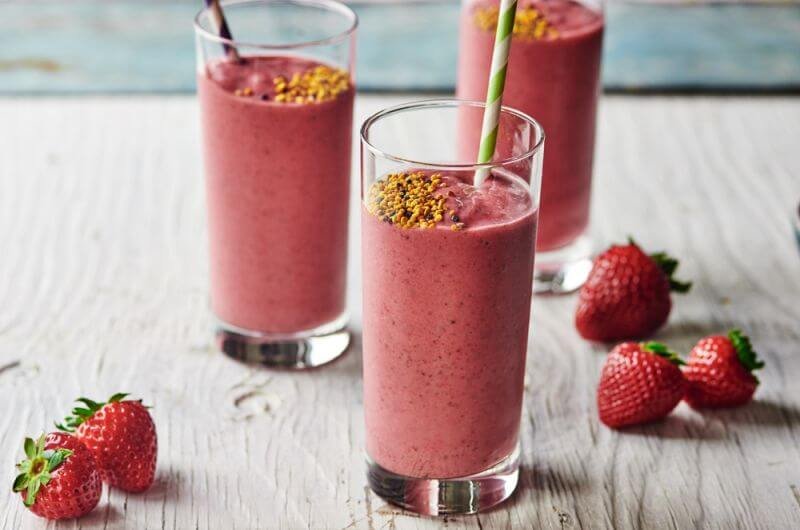[ad_1]
Fact Checked
Evidence Based
If you’re looking for a killer leg workout to build an impressive pair of gams, you’re in the right place.
In this article, you’ll learn the best leg workout for maximizing leg development.
Follow this leg day workout routine for 8-to-12 weeks, eat enough calories and protein, and get enough sleep, and I guarantee you’ll have a stronger and better-developed lower body on the other side.
The Ultimate Leg Workout
This intense leg day workout is guaranteed to build muscle and strength in all your lower-body muscle groups.
For optimal results, do the exercises in the order given, only do the workout once weekly, and avoid additional leg training throughout the week.
Barbell Back Squat
Sets: 3 | Reps: 4-to-6 | Rest: 3-to-5 min
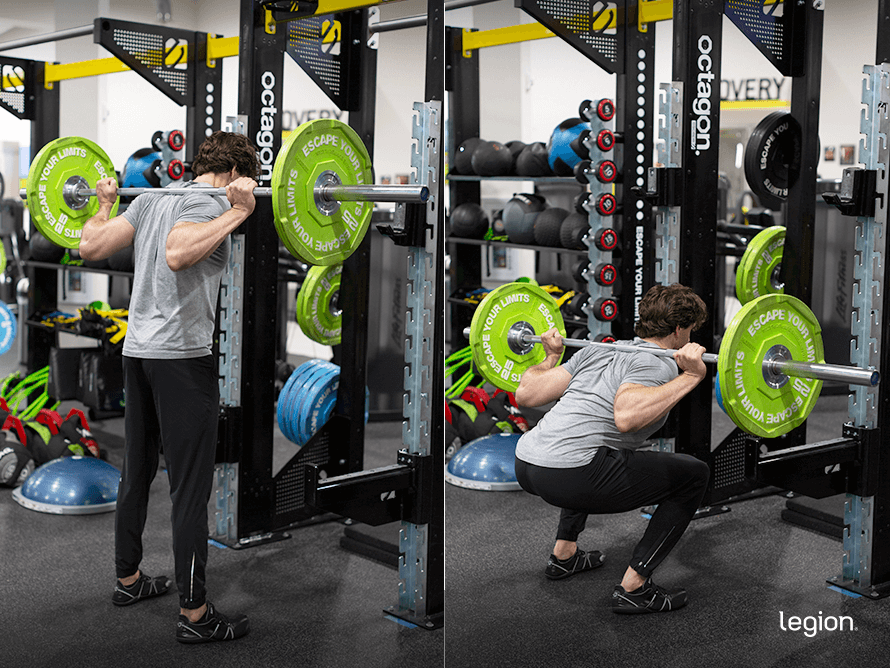
How to:
- Position a barbell in a squat rack at about the height of the top of your breastbone.
- Step under the bar, pinch your shoulder blades together, and rest the bar directly above the bony ridges on the bottom of your shoulder blades.
- Lift the bar out of the rack, take one or two steps backward, and place your feet flat on the floor a little wider than shoulder-width apart, with your toes pointing slightly outward.
- Sit down into the squat position and remember to keep your back straight and push your knees out in the same direction as your toes throughout each rep.
- Stand up and return to the starting position.
Common Mistakes: To prevent your knees from caving in as you stand up, imagine spreading the floor apart with your feet by driving your feet into the ground and away from each other (though they shouldn’t actually move). Doing so increases glute activation and enables you to lift more weight with a lower risk of pain or injury.
Romanian Deadlift
Sets: 3 | Reps: 6-to-8 | Rest: 3-to-5 min
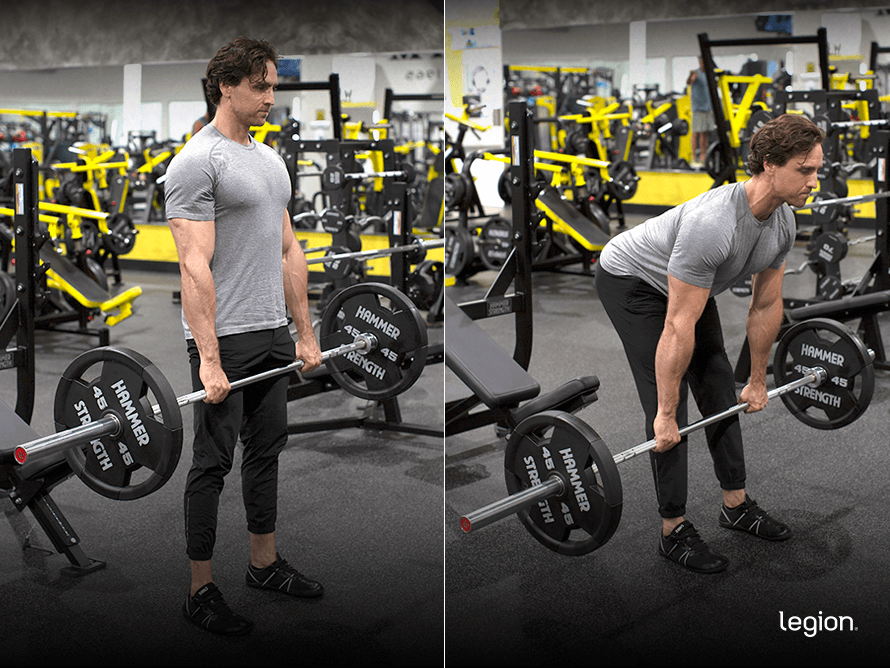
If you can’t do the RDL because of past injuries, substitute it for the hip thrust. The hip thrust trains the glutes and hamstrings to a high degree but places significantly less stress on your spine, making it a solid alternative to the RDL.
How to:
- Stand up straight holding a loaded barbell with a shoulder-width, overhand grip (palms facing toward your body).
- Flatten your back and lower the weights toward the floor in a straight line while keeping your legs mostly straight, allowing your butt to move backward as you descend.
- Once you feel a stretch in your hamstrings, bend your knees slightly more, and continue lowering the weights until your lower back begins to round—just below the knees for most people and about mid-shin for those who are particularly flexible.
- Squeeze your glutes and reverse the movement to return to the starting position.
Common Mistakes: Letting the barbell drift from your body heightens the chances of back rounding, which can lead to injury. The best ways to avoid this are to focus on dragging the bar up your body and contracting your upper back and lats throughout each rep.
Dumbbell Lunge
Sets: 3 | Reps: 6-to-8 | Rest: 3-to-5 min
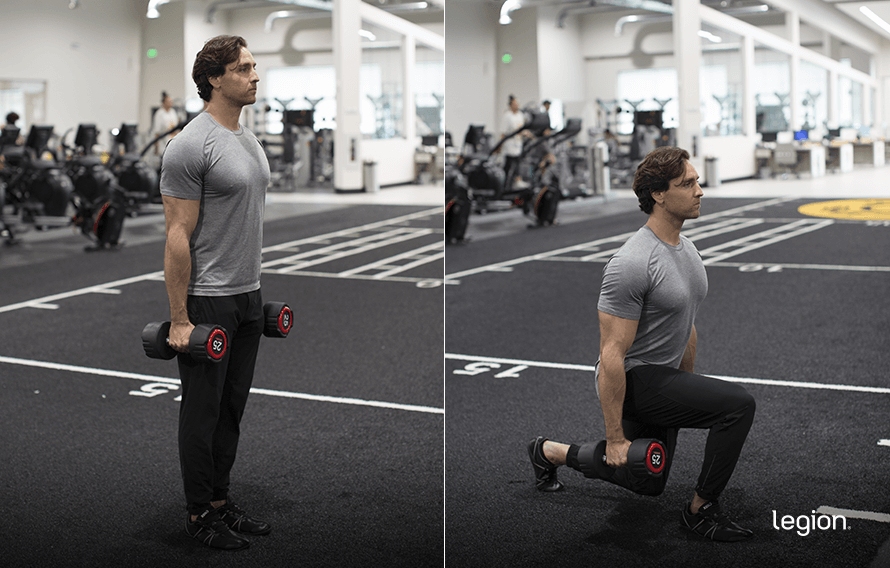
The regular forward lunge is the best option for overall leg development. However, if you want to emphasize your glutes, opting for the reverse lunge may be more fitting.
How to:
- Holding a dumbbell in each hand, stand up straight with both feet about shoulder-width apart.
- Take a long step forward with your right foot—about two to three feet—and plant your right foot flat on the floor. With most of your weight on your front foot, kneel down until your left knee touches the floor.
- Reverse the motion by pushing off the floor with your front foot and leaning slightly backward, allowing your legs to straighten.
- Once you’re standing, bring your right foot back to the starting position.
Common Mistakes: Lunging with your feet almost in line with each other makes balancing more difficult. Avoid this by ensuring your feet stay about hip-width apart throughout the exercise.
Leg Curl
Sets: 3 | Reps: 8-to-10 | Rest: 2-to-3 min
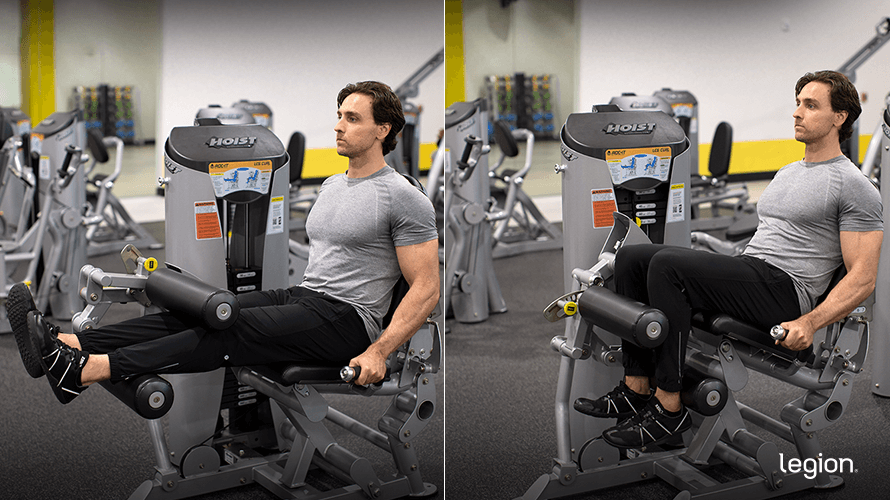
How to:
- Adjust the leg pad so that it rests against your mid-calf when you lie on the machine.
- Lie face down on the machine and grab the handles, then curl the pad toward your butt by pushing against the leg pad.
- Reverse the movement and return to the starting position.
Common Mistakes: Many people curl their feet toward their butt with control but let the weight yank their legs back to the starting position, robbing them of some of the muscle-building benefits of the exercise. Avoid this by completing the lifting and lowering portion of each rep with control.
Goblet Squat
Sets: 3 | Reps: 10-to-15 | Rest: 2-to-3 min
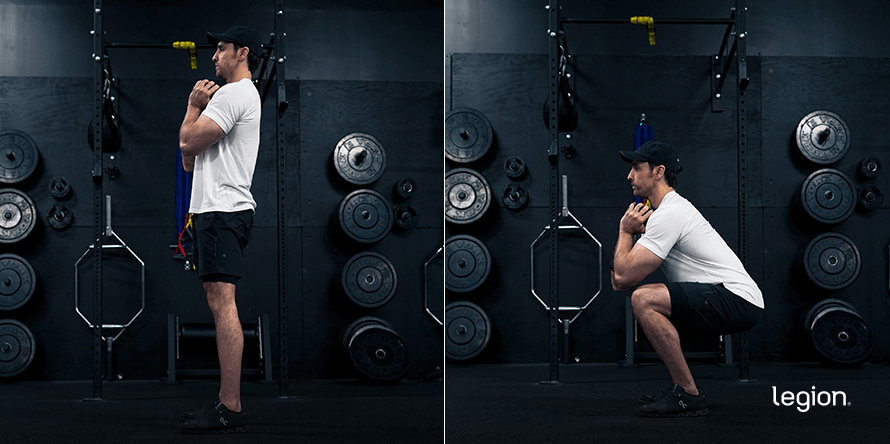
The goblet squat is an excellent addition to any leg day workout routine because it allows you to do extra volume for your legs without putting much strain on your knees or lower back.
How to:
- Hold a dumbbell in front of your chest with both hands.
- Place your feet a little wider than shoulder-width apart, point your toes out to the side at about a 45-degree angle, raise your chest, and sit down.
- Remember to keep your back straight and push your knees out in the same direction as your toes throughout each rep.
- Stand up and return to the starting position.
Common Mistakes: Holding the weight away from your body forces your biceps, forearms, and shoulders to bear weight, which makes balancing more challenging and limits the amount of weight you can lift. Correct this by holding the weight close to your chest with your elbows fully bent.
Standing Calf Raise
Sets: 3 | Reps: 10-to-30 | Rest: 2-to-3 min
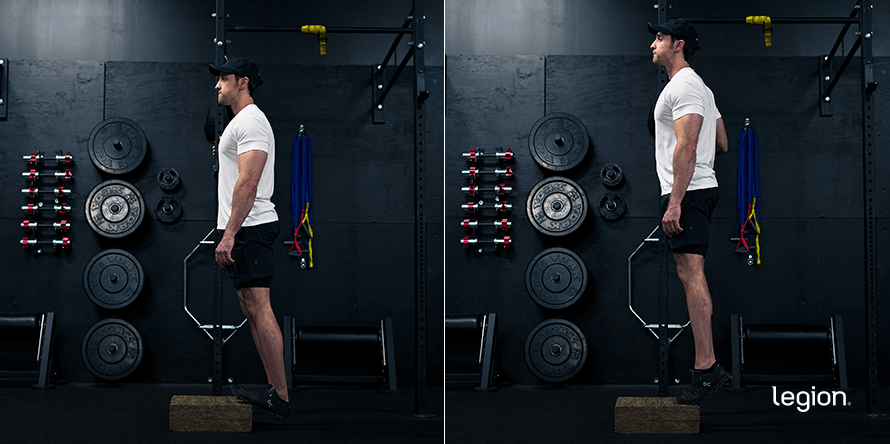
The standing calf raise trains the calf muscles, which aren’t just for looking jacked—they’re also for running faster, jumping higher and further, and improving stability during other lower-body exercises. Do the standing calf raise for high reps using only your body weight, or make it more intense by holding a dumbbell in your free hand.
How to:
- Place a calf raise block, step, or weight plate near something sturdy that you can use as a support (a squat rack or an adjustable bench set at a 90-degree angle works well).
- Place the ball of your left foot on the calf raise block and take hold of the support with your left hand.
- Raise your right foot off the floor by bending your knee.
- Raise your left heel as high as possible by pushing through the ball of your left foot.
- Lower your body as far as possible by lowering your left heel toward the floor.
- Once you’ve completed the desired number of reps, switch sides and repeat the process with your right leg.
Common Mistake: Many people cut the range of motion short on the standing calf raise. Avoid this by lowering your body until you feel a deep stretch in your calf, hold it for a beat, then press through the ball of your foot and return to the starting position.
Leg Workout Tips: How to Have the Best Leg Workouts Possible
Train with the right intensity.
To maximize the muscles- and strength-building effects of this leg day workout, push most sets close to muscle failure.
After each set, ask: “How many more reps could I have gotten with good form?” If the answer is more than two, increase the weight or reps to make your next set more challenging.
To maintain optimal intensity, you also need to increase the weights you lift as you get stronger. Do this by increasing the weights once you hit the top of your rep range for one set.
For example, if your workout calls for 4-to-6 reps of squats and you get 6 reps for a set, add 10 pounds total for your next set and work with that weight until you can (eventually) squat it for a set of 6 reps, and so forth.
If you get 3 or fewer reps after adding weight, reduce it by 5 pounds to remain within your target rep range (4-to-6) for all three sets.
Apply this progression method to all exercises in every workout.
Eat enough calories and protein.
You also need to eat enough protein to allow your leg muscles to recover, repair, and grow effectively. Aim to eat at least one gram of protein per pound of body weight per day.
Take the right supplements.
Here are the best supplements for supporting your leg workouts:
- 0.8-to-1.2 grams of protein per pound of body weight per day. This provides your body with the “building blocks” needed to build and repair muscle tissue and help you recover from your leg workouts. If you want a clean, convenient, and delicious source of protein, try Whey+ or Casein+.
- 3-to-5 grams of creatine per day. This will boost muscle and strength gain, improve anaerobic endurance, and reduce muscle damage and soreness from your leg workouts. If you want a 100% natural source of creatine that also includes two other ingredients that will help boost muscle growth and improve recovery, try Recharge.
- One serving of Pulse per day. Pulse is a 100% natural pre-workout drink that enhances energy, mood, and focus; increases strength and endurance; and reduces fatigue. You can also get Pulse with caffeine or without.
+ Scientific References
- Neto, Walter Krause, et al. “Gluteus Maximus Activation during Common Strength and Hypertrophy Exercises: A Systematic Review.” Journal of Sports Science & Medicine, vol. 19, no. 1, 24 Feb. 2020, pp. 195–203, www.ncbi.nlm.nih.gov/pmc/articles/PMC7039033/.
- Alkjaer, Tine, et al. “Computational Modeling of a Forward Lunge: Towards a Better Understanding of the Function of the Cruciate Ligaments.” Journal of Anatomy, vol. 221, no. 6, 11 Oct. 2012, pp. 590–597, https://doi.org/10.1111/j.1469-7580.2012.01569.x. Accessed 19 Sept. 2020.
- Osamu , Yanagisawa, and Fukutani Atsuki . Muscle Recruitment Pattern of the Hamstring Muscles in Hip Extension and Knee Flexion Exercises. 24 Jan. 2019.
- Wojtys, E M, et al. “Neuromuscular Adaptations in Isokinetic, Isotonic, and Agility Training Programs.” The American Journal of Sports Medicine, vol. 24, no. 2, 1996, pp. 187–92, www.ncbi.nlm.nih.gov/pubmed/8775118, https://doi.org/10.1177/036354659602400212. Accessed 4 Feb. 2020.
- Helms, Eric R, et al. “Evidence-Based Recommendations for Natural Bodybuilding Contest Preparation: Nutrition and Supplementation.” Journal of the International Society of Sports Nutrition, vol. 11, no. 1, 12 May 2014, www.ncbi.nlm.nih.gov/pmc/articles/PMC4033492/, https://doi.org/10.1186/1550-2783-11-20.
- Stokes, Tanner, et al. “Recent Perspectives Regarding the Role of Dietary Protein for the Promotion of Muscle Hypertrophy with Resistance Exercise Training.” Nutrients, vol. 10, no. 2, 7 Feb. 2018, p. 180, www.mdpi.com/2072-6643/10/2/180/pdf, https://doi.org/10.3390/nu10020180.
You May Also Like
Our Most Popular Evidence-Based Articles
You don’t need supplements to build muscle, lose fat, and get healthy. But the right ones can help.
Take our 60-second quiz now to learn which supplements can help you achieve your fitness goals faster.
Sending…
Your free stuff is on the way!
Follow the Diet Plan that Helped Nikita Lose 15 Pounds in 3 Months
“I never thought getting in shape would be this simple! Everything just WORKS when you follow this plan.” And if he can do it, why not you?

Wait!
Want a Free Custom Meal Planning Tool?
Quickly calculate your calories, macros, and micros for losing fat, building muscle, and staying healthy.
Our “No Return Necessary”
Money-Back Guarantee
If you don’t like something of ours, guess what happens next?
No, we don’t request you deliver it to a PO box in the Gobi Desert by carrier pigeon. Nor do we ask you to fill a cursed inkwell with orc’s blood and demon saliva and then use it to complete reams of return forms written in ancient Cyrillic script.
We just . . . wait for it . . . give you your money back. Holy moo cows. And that means you can say “yes” now and decide later.
Free Worldwide Shipping & Returns
Many companies use shipping and handling fees to increase their profit margins, but here at Legion, we hate profits, so our shipping is free!
Okay, so we do dig on profits, but we also go in for happy customers, and free shipping works like gangbusters. So, if you live in the United States, your order ships free regardless of order size, if you live in the UK or Canada, your order ships free when it’s over $99, and if you live elsewhere, your order ships free when it’s over $199.
Also, if you don’t absolutely love our stuff for whatever reason, we don’t request you deliver it to a PO box in the Gobi Desert by carrier pigeon.
We just . . . wait for it . . . give you your money back. No returns. No forms. No nonsense. Holy moo cows.
That means you can say “yes” now and decide later. You really have nothing to lose.
Free Worldwide Shipping & Returns
Many companies use shipping and handling fees to increase their profit margins, but here at Legion, we hate profits, so our shipping is free!
Okay, so we do dig on profits, but we also go in for happy customers, and free shipping works like gangbusters. So, if you live in the UK or Canada, your order ships free when it’s over $99.
Why the restriction on international orders? Unfortunately, shipping abroad is very expensive, and if we didn’t require a minimum order size, we’d lose a lot of money. But! We’re also hustling to improve our international logistics and will be passing our savings along to our international customers.
Also, if you don’t absolutely love our stuff for whatever reason, we don’t request you deliver it to a PO box in the Gobi Desert by carrier pigeon.
We just . . . wait for it . . . give you your money back. No returns. No forms. No nonsense. Holy moo cows.
That means you can say “yes” now and decide later. You really have nothing to lose.
Free Worldwide Shipping & Returns
Many companies use shipping and handling fees to increase their profit margins, but here at Legion, we hate profits, so our shipping is free!
Okay, so we do dig on profits, but we also go in for happy customers, and free shipping works like gangbusters. So, if you’re outside the USA, your order ships free when it’s over $199.
Why the restriction on international orders? Unfortunately, shipping abroad is very expensive, and if we didn’t require a minimum order size, we’d lose a lot of money. But! We’re also hustling to improve our international logistics and will be passing our savings along to our international customers.
Also, if you don’t absolutely love our stuff for whatever reason, we don’t request you deliver it to a PO box in the Gobi Desert by carrier pigeon.
We just . . . wait for it . . . give you your money back. No returns. No forms. No nonsense. Holy moo cows.
That means you can say “yes” now and decide later. You really have nothing to lose.
Clinically Effective Ingredients & Doses
Many ingredients in supplements don’t have any scientifically validated benefits, and many ingredients that do are often underdosed to the point of irrelevance.
That’s why we only use the choice ingredients and precise doses shown to be effective in peer-reviewed scientific studies.
Clinically Effective Doses
You need more than great ingredients to make great products—you also need proper doses. That’s why we use the precise doses of ingredients shown to be effective in peer-reviewed scientific studies.
100% Natural Ingredients
“Natural” doesn’t always mean “better,” but in many cases, natural ingredients are superior to artificial ones for various reasons, including purity, safety, and efficacy.
That’s why all of our ingredients in all of our products come from plant and animal sources, including sweeteners, colors, and flavors.
Made in USA
If you want to ensure the supplements you’re swallowing every day are safe and effective, you want products produced in the USA.
That’s why all of our supplements are made in America in NSF-certified and FDA-inspected facilities that operate in accordance with the Current Good Manufacturing Practice (cGMP) regulations.
Lab Tested
Did you know that supplements can contain dangerously high levels of toxins like lead, arsenic, and cadmium?
That’s why we test every ingredient of every supplement we produce for heavy metals, microbes, allergens, and other contaminants and ensure they meet the strict purity standards set by the FDA.
Naturally Sweetened & Flavored
While artificial sweeteners may not be as dangerous as some people claim, studies suggest that regular consumption of these chemicals may indeed be harmful to our health.
That’s why all of our supplements are naturally sweetened and flavored and contain no artificial food dyes, fillers, or other unnecessary junk.
Science-Backed Ingredients
Many ingredients in supplements don’t have any scientifically validated benefits. That’s why we only use choice ingredients shown to be effective in peer-reviewed scientific studies.
No Chemical Junk
“Natural” doesn’t always mean “better,” but in many cases, natural ingredients are superior to artificial ones for various reasons, including purity, safety, and efficacy.
That’s why all of our ingredients in all of our products come from plant and animal sources, including sweeteners, colors, and flavors.


Split your entire online purchase into 4 interest-free payments, over 6 weeks with no impact to your credit.

25%
today
25%
2 weeks
25%
4 weeks
25%
6 weeks

Shop and add items to your cart as normal!

Choose Sezzle at Checkout! You’ll be redirected to Sezzle to Sign Up or Log In
to complete your order.

Your order will be shipped out right away* and your payments will be split up
over 6 weeks.
*shipping times subject to merchant shipping policy
Shop directory. Reschedule payments. Plus more!
Waiver and Release of Liability
In consideration of the services and/or products offered by Legion Athletics, Inc. (“Legion”) including, but not limited to, nutrition plans, exercise routines and coaching, and in addition to the payment of any fee or charge:
I knowingly and voluntarily enter into this waiver and release of liability and hereby waive any and all rights, claims or causes of action of any kind whatsoever arising out of my use of Legion’s services and/or products, and I hereby release and hold harmless Legion and its consultants, officers, contractors, agents, owners and employees from any and all responsibility, liability, cost and expenses, including for injuries, damages or disorders (physical, metabolic, or otherwise), resulting from my use of Legion’s services and/or products.
I understand that fitness activities including, but not limited to, strength, flexibility, and cardiovascular exercise, with or without the use of equipment, are potentially hazardous activities that involve a risk of injury and even death, and I am voluntarily participating in these activities and using equipment and machinery with knowledge of the risks involved. I hereby agree to assume and accept any and all risks of injury or death related to said fitness activities.
I understand Legion’s services and products are not meant to treat or manage any health conditions or circumstances, and I acknowledge that Legion has recommended I obtain a healthcare provider’s approval for my use of Legion’s services and/or products, through regular physical examination(s) and/or consultation. I acknowledge that I have obtained my healthcare provider’s approval or have decided to use Legion’s services and/or products without such approval and hereby assume all responsibility for my use of said services and/or products.
I understand that results from using Legion’s products and/or services are not guaranteed, and I agree to not hold Legion liable for any outcomes or lack thereof.
OUT OF STOCK
Security Check
Please click the checkbox below. We apologize for the inconvenience.
If you don’t absolutely love this product, just let us know, and we’ll give you a full refund on the spot. No forms or return necessary.
Analyzed for purity and potency in a state-of-the-art ISO 17025 accredited lab by Labdoor™, the gold standard of third-party lab testing.
Analyzed for purity and potency in a state-of-the-art ISO 17025 accredited lab, the gold standard of third-party lab testing.
This product doesn’t just “contain natural ingredients’’—every ingredient is naturally sourced from plants and animals. This product contains no artificial or synthetic substances of any kind.
Fact Checked
Our scientific review board of nutritionists, dietitians, molecular biologists, doctors, and other accredited experts is responsible for reviewing every article, podcast, and video we produce to ensure they’re evidence based, accurate, trustworthy, and current.
Thanks to their connections, credentials, and academic experience, this team of MDs, PhDs, and other professionals has access to a wealth of research published in the largest and most prestigious journals in the world.
This allows them to not only review individual studies but also analyze the overall weight of the evidence on any and all topics related to diet, exercise, supplementation, and more.
If you feel that any of our content is inaccurate, misleading, out-of-date, or anything less than factual, please let us know in the comments section of the article in question.
Evidence Based
We follow a detailed, rigorous, multi-step process to create content that meets the highest standards of clarity, practicality, and scientific integrity.
First, our research associates provide our editorial team with accurate, up-to-date, proven scientific evidence.
Then, our editorial team uses this research to draft articles and outlines for podcasts and videos.
Finally, our scientific review board reviews the content to ensure all key information and claims are backed by high-quality scientific research and explained simply and precisely.
If you feel that any of our content is inaccurate, misleading, out-of-date, or anything less than factual, please let us know in the comments section of the article in question.
[ad_2]
Source link




